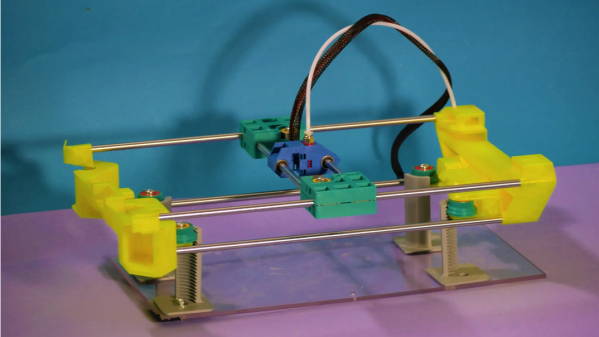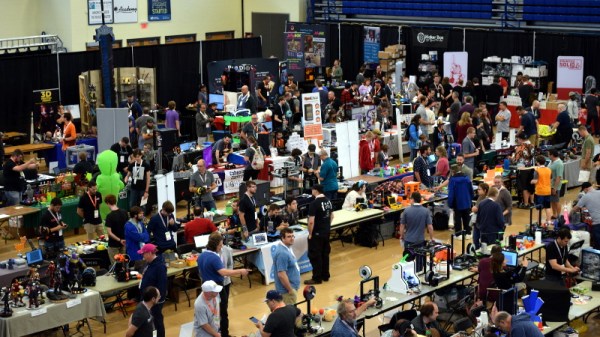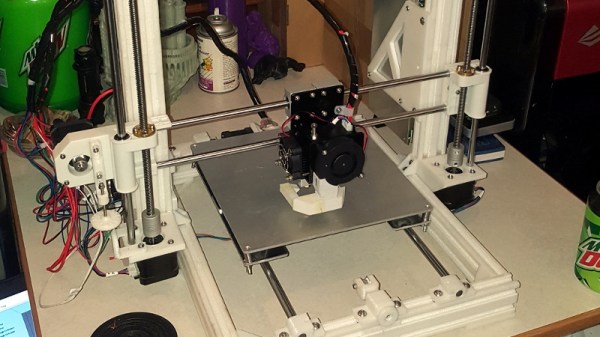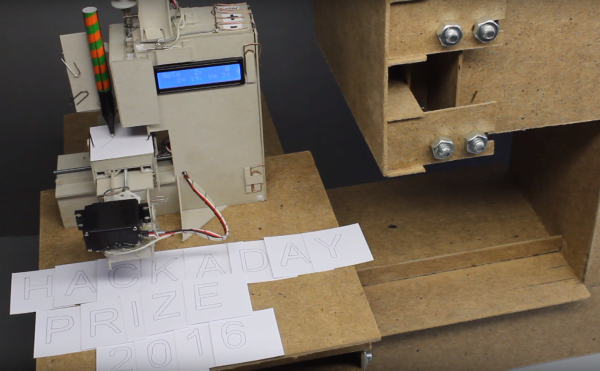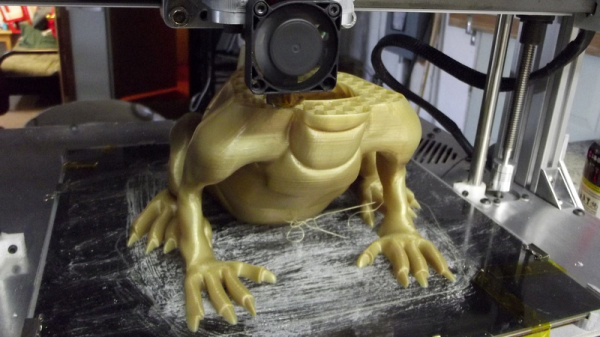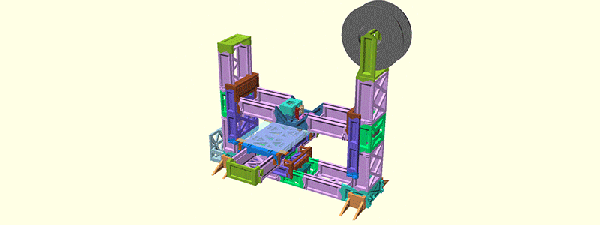Despite the best efforts of the RepRap community over the last twenty years, self-replicating 3D printers have remained a stubbornly elusive goal, largely due to the difficulty of printing electronics. [Brian Minnick]’s fully-printed 3D printer could eventually change that, and he’s already solved an impressive number of technical challenges in the process.
[Brian]’s first step was to make a 3D-printable motor. Instead of the more conventional stepper motors, he designed a fully 3D-printed 3-pole brushed motor. The motor coils are made from solder paste, which the printer applies using a custom syringe-based extruder. The paste is then sintered at a moderate temperature, resulting in traces with a resistivity as low as 0.001 Ω mm, low enough to make effective magnetic coils.
self-replicating8 Articles
Infinite Z-Axis Printer Aims To Print Itself Someday
“The lathe is the only machine tool that can make copies of itself,” or so the saying goes. The reality is more like, “A skilled machinist can use a lathe to make many of the parts needed to assemble another lathe,” which is still saying quite a lot by is pretty far off the implication that lathes are self-replicating machines. But what about a 3D printer? Could a printer print a copy of itself?
Not really, but the Infini-Z 3D printer certainly has some interesting features that us further down the road to self-replication. As the name implies, [SunShine]’s new printer is an infinite Z-axis design that essentially extrudes its own legs, progressively jacking its X- and Y-axis gantry upward. Each leg is a quarter of an internally threaded tube that engages with pinion gears to raise and lower the gantry. When it comes time to grow the legs, the print head moves into each corner of the gantry and extrudes a new section onto the top of each existing leg. The threaded leg is ready to use in minutes to raise the gantry to the next print level.
The ultimate goal of this design is to create a printer that can increase its print volume enough to print a copy of itself. At this moment it obviously can’t print a practical printer — metal parts like bearings and shafts are still needed, not to mention things like stepper motors and electronics. But [SunShine] seems to think he’ll be able to solve those problems now that the basic print volume problem has been addressed. Indeed, we’ve seen complex print-in-place designs, assembly-free compliant mechanisms, and even 3D-printed metal parts from [SunShine] before, so he seems well-positioned to move this project forward. We’re eager to see where this goes. Continue reading “Infinite Z-Axis Printer Aims To Print Itself Someday”
East Coast RepRap Festival Comes Alive In Second Year
By pretty much any metric you care to use, the inaugural East Coast RepRap Festival (ERRF) in 2018 was an incredible success. There was plenty to see, the venue was accommodating, and the ticket prices were exceptionally reasonable. But being a first-time event, there was an understandable amount of trepidation from both exhibitors and the attendees. Convincing people to travel hundreds of miles to an event with no track record can be a difficult thing, and if there was a phrase that would best describe the feel of that first ERRF, it would probably have been “cautious optimism”.
 But this year, now that they had some idea of what to expect, the 3D printing community descended on Bel Air, Maryland with a vengeance. In 2019, everything at ERRF was bigger and better. There were more people, more printers, and of course, more incredible prints. Activities like the 3D Printed Derby returned, and were joined by new attractions including full-body 3D scanning and a shooting gallery where attendees could try out the latest in printable NERF weaponry.
But this year, now that they had some idea of what to expect, the 3D printing community descended on Bel Air, Maryland with a vengeance. In 2019, everything at ERRF was bigger and better. There were more people, more printers, and of course, more incredible prints. Activities like the 3D Printed Derby returned, and were joined by new attractions including full-body 3D scanning and a shooting gallery where attendees could try out the latest in printable NERF weaponry.
The official tally shows that attendance nearly doubled over last year, and with growth like that, we wouldn’t be surprised if the ERRF organizers consider relocating to a larger venue for 2020 or 2021. As far as problems go, growth so explosive that it requires you to rethink where you hold the event isn’t a bad one to have. The Midwest RepRap Festival, which served as the inspiration for ERRF, found they too needed to move into more spacious digs after a few years. Something to keep in mind the next time somebody tells you the bubble has burst on desktop 3D printing.
Trying to distill an event as large and vibrant as ERRF 2019 into a few articles is always difficult. Even after spending hours walking around the show floor, you would still stumble upon something you hadn’t seen previously. As such, this article is merely a taste of what was on hand. The East Coast RepRap Festival 2020 should absolutely be marked on your calendar for next year, but until then let’s take a look at just some of what made this year’s event such a smash.
Continue reading “East Coast RepRap Festival Comes Alive In Second Year”
3D Print A 3D Printer Frame
It is over a decade since the RepRap project was begun, originally to deliver 3D printers that could replicate themselves, in other words ones that could print the parts required to make a new printer identical to themselves. And we’re used to seeing printers of multiple different designs still constructed to some extent on this principle.
The problem with these printers from a purist replicating perspective though is that there are always frame parts that must be made using other materials rather than through the 3D printer. Their frames have been variously threaded rod, lasercut sheet, or aluminium extrusion, leaving only the fittings to be printed. Thus [Chip Jones]’ Thingiverse post of an entirely 3D printed printer frame using a 3D printed copy of aluminium extrusion raises the interesting prospect of a printer with a much greater self-replicating capability. It uses the parts from an Anet A8 clone of a Prusa i3, upon which it will be interesting to see whether the 3D printed frame lends the required rigidity.
There is a question as to whether an inexpensive clone printer makes for the most promising collection of mechanical parts upon which to start, but we look forward to seeing this frame and its further derivatives in the wild. Meanwhile this is not the most self-replicating printer we’ve featured, that one we covered in 2015.
Thanks [MarkF] for the tip.
Cardboard And Paperclip CNC Plotter Destined For Self-Replication
Last November, after [HomoFaciens]’ garbage-can CNC build, we laid down the gauntlet – build a working CNC from cardboard and paperclips. And now, not only does OP deliver with a working CNC plotter, he also plans to develop it into a self-replicating machine.
To be honest, we made the challenge with tongue firmly planted in cheek. After all, how could corrugated cardboard ever make a sufficiently stiff structure for the frame of a CNC machine? [HomoFaciens] worked around this by using the much less compliant chipboard – probably closest to what we’d call matboard here in the States. His templates for the machine are extremely well thought-out; the main frame is a torsion box design, and the ways and slides are intricate affairs. Non-cardboard parts include threaded rod for the lead screws, servos modified for continuous rotation, an Arduino, and the aforementioned paperclips, which find use in the user interface, limit switches, and in the extremely clever encoders for each axis. The video below shows highlights of the build and the results.
True, the machine can only move a pen about, and the precision is nothing to brag about. But it works, and it’s perfectly capable of teaching all the basics of CNC builds to a beginner, which is a key design goal. And it’s well-positioned to move to the next level and become a machine that can replicate itself. We’ll be watching this one very closely.
Continue reading “Cardboard And Paperclip CNC Plotter Destined For Self-Replication”
Getting It Right By Getting It Wrong: RepRap And The Evolution Of 3D Printing
The beginning of the DIY 3D printing movement was a heady time. There was a vision of a post-scarcity world in which everything could and would be made at home, for free. Printers printing other printers would ensure the exponential growth that would put a 3D printer in every home. As it says on the front page: “RepRap is humanity’s first general-purpose self-replicating manufacturing machine.” Well, kinda.
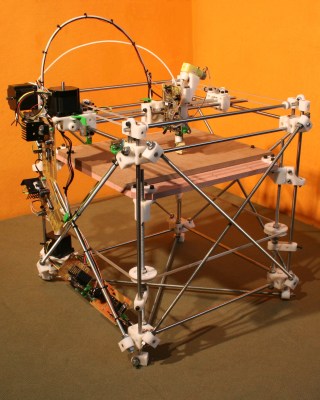
Just to set the record straight, I love the RepRap project. My hackerspace put our funds together to build one of the first few Darwins in the US: Zach “Hoeken” came down and delivered the cut-acrylic pieces in person. I have, sitting on my desk, a Prusa Mendel with 3D parts printed by Joseph Prusa himself, and I spent a fantastic weekend with him and Kliment Yanev (author of Pronterface) putting it together. Most everyone I’ve met in the RepRap community has been awesome, giving, and talented. The overarching goal of RepRap — getting 3D printers in as many peoples’ hands as possible — is worthy.
But one foundational RepRap idea(l) is wrong, and unfortunately it’s in the name: replication. The original plan was that RepRap printers would print other printers and soon everyone on Earth would have one. In reality, an infinitesimal percentage of RepRap owners print other printers, and the cost of a mass-produced, commercial RepRap spinoff is much less than it would cost me to print you one and source the parts. Because of economies of scale, replicating 3D printers one at a time is just wasteful. Five years ago, this was a controversial stance in the community.
On the other hand, the openness of the RepRap community has fostered great advances in the state of the DIY 3D printing art. Printers haven’t reproduced like wildfire, but ideas and designs have. It’s time to look back on the ideal of literal replication and realize that the replication of designs, building methods, and the software that drives the RepRap project is its great success. It’s the Open Hardware, smarty! A corollary of this shift in thought is to use whatever materials are at hand that make experimentation with new designs as easy as possible, including embracing cheap mass-produced machines as a first step. The number of RepRaps may never grow exponentially, but the quality and number of RepRap designs can.
Continue reading “Getting It Right By Getting It Wrong: RepRap And The Evolution Of 3D Printing”
The Most Self-Replicating RepRap Yet
The goal of the RepRap project was always a machine that could replicate itself. The project began with the RepRap Darwin, a machine with a frame made nearly entirely of threaded rods, and progressed to the Mendel, with a slightly higher proportion of printed parts. Around 2011, the goal of self-replication fell by the wayside after some money was thrown around. The goal now, it seems, is to create the 3D printer with the best profit margins. That doesn’t mean there still isn’t a small contingent of RepRappers out there trying to improve the status quo and create a printer that can truly self-replicate. [Revar] is one of those tinkerers, and he has just released the RepRap Snappy, a snap-together 3D printer built nearly entirely out of 3D printed parts.
Other 3D printers designed around the idea of self-replication, like the RepRap Morgan and the Simpson family of printers, use strange kinematics. The reason for this is that Cartesian bots can’t print up to the limits of their frame, yet self-replication requires all parts be replicated at the same scale.
[Revar] is setting a new tack in the problem of printer self-replication and is joining parts together with snap fit connectors. The entire frame of the Snappy printer is built out of small parts that interlock to form larger units.
Another of the tricks up [Revar]’s scheme is reducing the number of ‘vitamins’ or parts that cannot be 3D printed. This includes belts, motors, screws, and electronics. You can’t really print machine screws yet, but [Revar] did manage to eliminate some belts and bearings. He’s using a rack and pinion system, all made with printed parts. It’s a technique that hasn’t been seen before, but it does seem to work rather well.
[Revar] has made all the files for the printed parts available in his repository. If you have enough filament, these files are enough to print 73% of the RepRap Snappy.
Thanks [Matt] for sending this one in. Video below.


